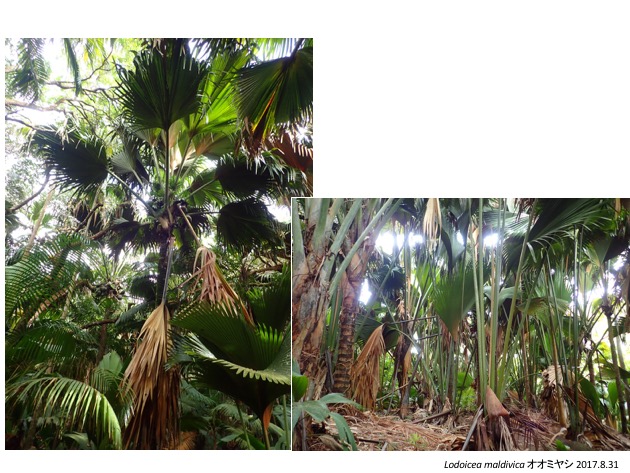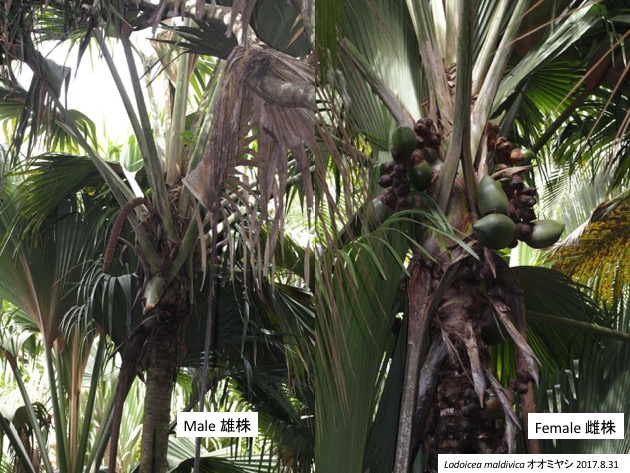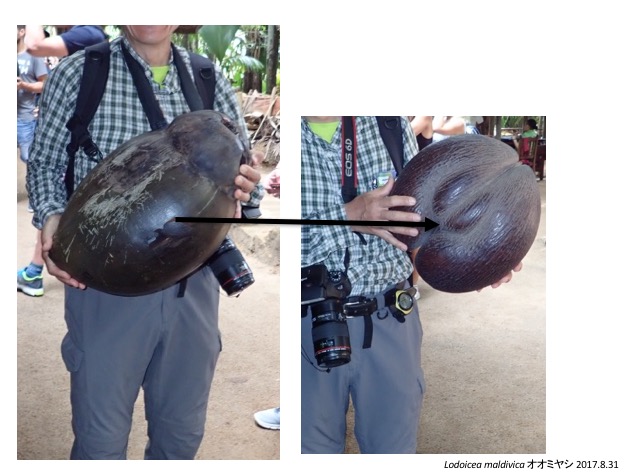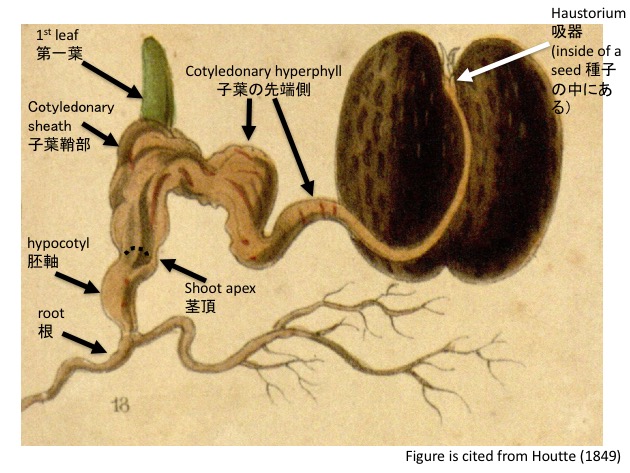
オオミヤシはインド洋にあるセーシェル共和国のいくつかの島に分布していたが、現在はプラランPraslin島とキュリューズCurieuse島のみに自生する(Dransfield et al. 2008)。樹高が高いものでは30メートルにもなる(Edwards et al. 2002) 。
Lodoicea maldivica is distributed in some islands in the Seychelles but now only in the Pralsin and Curieuse islands (Dransfield et al. 2008). The height reaches up to 30 m (Edwards et al. 2002).

雌雄異株で果実は熟すのに6,7年を要する (Edwards et al. 2002)。
Lodoicea maldivica is dioecious and fruits take six to seven years to mature (Edwards et al. 2002).

果実は20 kg、その中に通常1つ含まれる種子は約10 kgあり、世界最大の種子である(Edwards et al. 2002) 。種子は重く、水に沈むので海流などによって分布を広げることは難しいと考えられるが、いくつかの島に分布しているのはどうしてなのだろうか。
Fruits and seeds are approximately 20 kg and 10 kg, respectively and the largest seed in seed plants (Edwards et al. 2002). However, it is curious how Lodoicea maldivica expanded its distribution to some islands, since fruits and seeds are too heavy to float on the sea.

種子の窪みから発芽すると、子葉の先端が種子の中に吸器として残り、4年ほど種子から栄養を得続ける(Edwards et al. 2002)。大きな種子から長期間にわたって栄養を得ることで、少なくとも以下の2つのメリットが考えられる (Edwards et al. 2002)。一つ目は、子葉の先端側が、長いもので10 mも伸びて親から離れたところに芽生えを作れることである(Edwards et al. 2002)。二つ目は、大きな種子からの栄養のおかげで発芽後すぐに1.5 mもの大きな葉を作れることである(Edwards et al. 2002)。島に生育するフタゴヤシは、遠くに種子を飛ばして繁殖することができないので、散布に適した種子を作るのではなく、上記二つの戦略で自分の親や兄弟を含めた周りの植物との競争に勝つため、種子がどんどん巨大化していったと推定されている(Edwards et al. 2002)。図の用語はTillich (2007)に基づく。
After germination from a seed, the cotyledon tip remains in the seed as a haustorium for approximately four years to get nutrients (Edwards et al. 2002). There are two advantages of big seeds. One is to make seedlings distantly from seeds. Cotyledonary hyperphyll elongates and sometimes extends to 10 m (Edwards et al. 2002). At the distance from the seed, the seedling starts to grow. This is advantageous to grow distantly from mother plants and siblings. Another advantage is to be able to make a large leaf even in the early growth phase. The first leaf of Lodoicea maldivica extends to 1.5 m high (Edwards et al. 2002). In the island, seeds cannot be dispersed beyond the island and are not necessary to be smaller or suitable for disparsal, therefore, seeds appear to be gigantic to fulfil the above two advantages (Edwards et al. 2002). Terms in the figure is based on Tillich (2007).
Dransfield J, Uhl NW, Asmussen CB, Baker WJ, Harley MM, Lewis CE. 2008 Genera Palmarum. London: Kew Publishing, Royal Botanic Gardens, Kew.
Edwards, P.J., Kollmann, J., and Fleischmann, K. (2002). Life history evolution in Lodoicea maldivica (Arecaceae). Nord. J. Bot. 22, 227–237.
Tillich HJ. (2007) Seedling diversity and the homologies of seedling organs in the order Poales (monocotyledons). Ann. Bot. 100, 1413–1429.
van Houtte, L. (1849) Flore des serres et des jardin de l’Europe. 5, 526.
